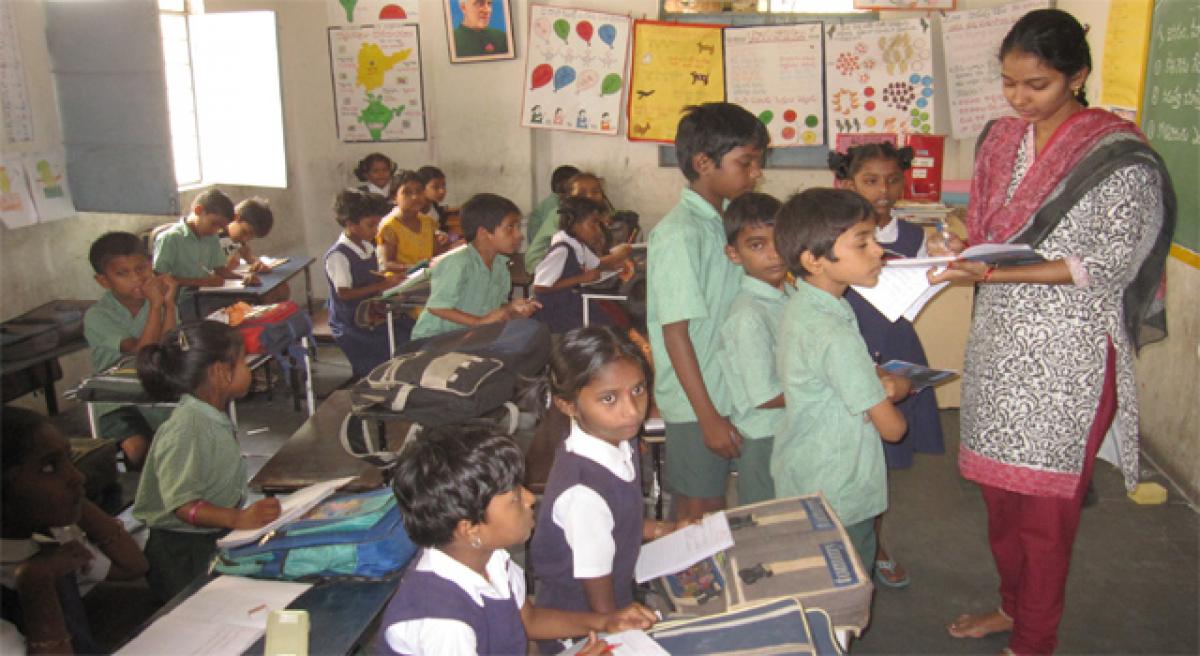Live
- PM Modi highlights govt's efforts to make Odisha prosperous and one of the fastest-growing states
- Hezbollah fires 200 rockets at northern, central Israel, injuring eight
- Allu Arjun's Family Appearance on Unstoppable with NBK Breaks Viewership Records
- Unity of hearts & minds essential for peace & progress, says J&K Lt Governor
- IPL 2025 Auction: I deserve Rs 18 cr price, says Chahal on being acquired by Punjab Kings
- EAM Jaishankar inaugurates new premises of Indian embassy in Rome
- Sailing vessel INSV Tarini embarks on second leg of expedition to New Zealand
- Over 15,000 people affected by rain-related disasters in Sri Lanka
- IPL 2025 Auction: RCB acquire Hazlewood for Rs 12.50 cr; Gujarat Titans bag Prasidh Krishna at Rs 9.5 crore
- Maharashtra result reflects the outcome of Congress' destructive politics: BJP's Shazia Ilmi
Just In

In India, 5th September is celebrated as Teachers’ Day as a mark of tribute to the contribution made by teachers to the society. 5th September is the birthday of a great philosopher, teacher, educationalist, humanist and religion thinker Dr Sarvapalli Radhakrishnan, who was a staunch believer of education, and was the well-known diplomat, scholar, President of India and above all a Teacher.
In India, 5th September is celebrated as Teachers’ Day as a mark of tribute to the contribution made by teachers to the society. 5th September is the birthday of a great philosopher, teacher, educationalist, humanist and religion thinker Dr Sarvapalli Radhakrishnan, who was a staunch believer of education, and was the well-known diplomat, scholar, President of India and above all a Teacher.
When Dr Radhakrishnan became the President of India in 1962, he was approached by some of his students and friends and requested him to allow them to celebrate 5th September, his “Birthday”. In reply, Dr Radhakrishnan said, “Instead of celebrating my birthday separately, it would be my proud privilege if September 5 is observed as Teachers’ Day”.
The request showed his love for the teaching profession. From then onwards, the day has been observed as Teachers’ Day in India. Mother is always the first teacher for the child, the next one is the teacher who teaches us according to Gita the teacher is considered as God.
Teachers are like real potters who not only give our life a shape, but also enable to lit like a lamp forever after dispelling the darkness from all across the world. Teachers creating a positive relationship with their students. Understanding the child’s problem, fear, confusion will give the teacher a better understanding the child’s learning difficulties.
Once the teacher becomes aware of the problems, he or she will have more patience with the student, thus making the child feel secure or less confused when learning is taking place in the classroom. Role of Teachers: Teachers play an important role in the trajectory of students throughout the formal schooling experience.
Teachers have the unique opportunity to support students academic and social development at all levels of schooling, positive teacher-student relationship enable students to feel safe and secure in their learning environments and provide scaffolding for important social and academic skills.
When teachers form positive bonds with students, classrooms become supportive spaces in which student can engage in academically and socially productive ways. Positive teacher-student relationships are classified as having the presence of closeness, warmth and positivity.
Students who have positive relationships with their teachers use them as a secure base from which they can explore the classroom and school setting both academically and socially, to take on academic challenges and work on social emotional development it includes, relationship with peers and developing self-esteem and self-concept through this secure relationship, students learn about socially appropriate behaviors as well as academic expectations and how to achieve these expectations.
Academic Outcomes: Teacher –student relationships are important in transition from elementary to middle to high school. Studies of math competence in students transitioning from elementary to middle school have found that students who move from having positive relationships with teachers at the end of elementary school to less positive relationships with teachers in middle school significantly decreased in math skills.
For students who are considered at high risk for dropping out of high school, math achievement is significantly impacted by the perception of having a caring teacher. Students who went from low teacher closeness to high teacher closeness significantly increased in math skills over the transition year. Motivation may play a key role in the relationship between teacher-student relationships and academic outcomes.
Social Outcomes: Teachers are an important source of social capital for students. Social capital in a classroom setting is defined as caring teacher-student relationships where students feel that they are both cared for and expected to succeed.
Social capital from positive teacher-student relationships can manifest itself in many different ways for high school students, positive teacher-student relationship can reduce rates of dropping out by nearly half, help explore options for college and provide support for further academic or vocational aspirations.
Conclusion and limitations: Currently, high school dropout rates are high, and improving teacher-student relationships for students at this stage may decrease dropout rates.
By: M Neeraja

© 2024 Hyderabad Media House Limited/The Hans India. All rights reserved. Powered by hocalwire.com







